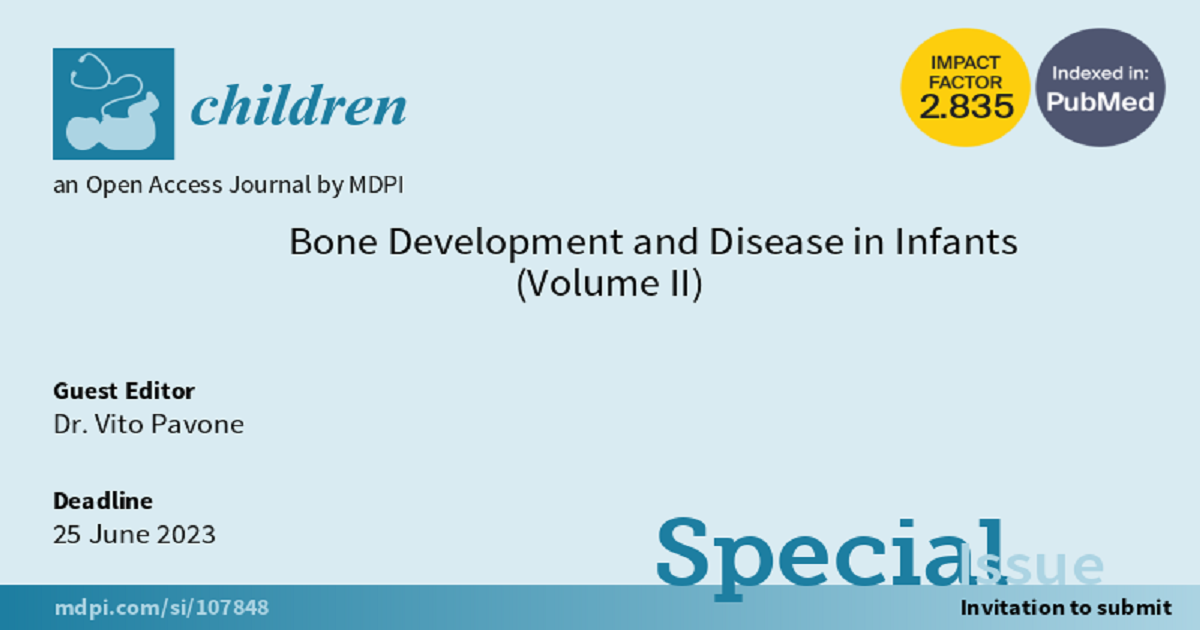- 2.1Impact Factor
- 3.8CiteScore
- 16 daysTime to First Decision
Bone Development and Disease in Infants (Volume II)
This special issue belongs to the section “Pediatric Orthopedics & Sports Medicine“.
Special Issue Information
Dear Colleagues,
I cordially invite you to contribute to a Special Edition of Children, dedicated to bone development and diseases in infants.
Children’s bone growth is continuous, and remodeling is always extensive. Growth proceeds from a vulnerable part of the bone, the growth plate. In remodeling, old bone tissue is gradually replaced by new tissue. Many bone disorders arise from the changes that occur in a growing child’s musculoskeletal system, and these disorders can positively or negatively impact bone development. Other bone disorders may be inherited or occur in childhood for unknown reasons.
Bone disorders in children can result from factors that affect people of all ages, including injury, infection (osteomyelitis), cancer, and metabolic diseases. Causes of bone disorders can involve the gradual misalignment of bones and stress on growth plates during growth. Congenital deformities such as clubfoot or developmental dysplasia of the hip can lead to important alterations of bone development, causing severe dysfunction. Certain rare connective tissue disorders can also affect the bones, such as Marfan syndrome, osteogenesis imperfecta, and osteochondrodysplasias.
Many specialists are involved in the management of bone development disorders in children and adolescents, such as neurosurgeons, plastic surgeons, general surgeons, ORL surgeons, maxillofacial surgeons, orthopedics, radiologists, and pediatric intensive care physicians.
The aim of this Special Issue is to present the latest research on the etiology, physiopathology, diagnosis and screening, management, and rehabilitation related to bone development and disease in infants, focusing on congenital, developmental, post-traumatic, and post-infective disorders.
Prof. Vito Pavone
Guest Editor
Manuscript Submission Information
Manuscripts should be submitted online at www.mdpi.com by registering and logging in to this website. Once you are registered, click here to go to the submission form. Manuscripts can be submitted until the deadline. All submissions that pass pre-check are peer-reviewed. Accepted papers will be published continuously in the journal (as soon as accepted) and will be listed together on the special issue website. Research articles, review articles as well as short communications are invited. For planned papers, a title and short abstract (about 250 words) can be sent to the Editorial Office for assessment.
Submitted manuscripts should not have been published previously, nor be under consideration for publication elsewhere (except conference proceedings papers). All manuscripts are thoroughly refereed through a single-blind peer-review process. A guide for authors and other relevant information for submission of manuscripts is available on the Instructions for Authors page. Children is an international peer-reviewed open access monthly journal published by MDPI.
Please visit the Instructions for Authors page before submitting a manuscript. The Article Processing Charge (APC) for publication in this open access journal is 2400 CHF (Swiss Francs). Submitted papers should be well formatted and use good English. Authors may use MDPI's English editing service prior to publication or during author revisions.
Keywords
- congenital disease
- developmental bone affection
- lower limb deformity
- foot
- hip pathology
- hand and wrist
- knee
- arthritis

Benefits of Publishing in a Special Issue
- Ease of navigation: Grouping papers by topic helps scholars navigate broad scope journals more efficiently.
- Greater discoverability: Special Issues support the reach and impact of scientific research. Articles in Special Issues are more discoverable and cited more frequently.
- Expansion of research network: Special Issues facilitate connections among authors, fostering scientific collaborations.
- External promotion: Articles in Special Issues are often promoted through the journal's social media, increasing their visibility.
- e-Book format: Special Issues with more than 10 articles can be published as dedicated e-books, ensuring wide and rapid dissemination.

